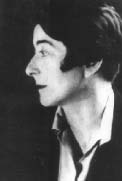Gray, Eileen
Irish interior, furniture and architectural designer who studied at the Slade School of Art in London. In 1902, she moved to Paris for further study at the Académie Julian and the Académie Colarassi. Gray moved back and forth between Paris, London and Ireland, and in 1905 became interested in the lacquer industry. She worked with Japanese lacquer craftsman Seizo Sugawara in Paris from 1906 to 1911 and by 1913 was exhibiting her own work. Not incidentally, she was an aviation enthusiast who in 1909 crossed the English Channel in a balloon with Charles S. Rolls of Rolls-Royce fame.
In 1914, when war broke out, Gray and Sugawara moved to London to continue their work. After World War I, she expanded her work into interior design, furniture and carpets. She designed her daring and innovative bright red Bibendum lounging chair in 1921. The chair was named for a character created by Michelin to sell tires because of its resemblance to two inflated half tires on top of a full tire. Its success encouraged her to open a gallery in Paris in 1922.
Turning to architecture in 1923, she designed a house at Rocquebrune-Cap-Martin in southern France as well as a number of prominent interiors. As a member of the Union des Artistes Modernes in the late ‘20s and early ‘30s, she was described as “occupying the center of the modern movement” by an architectural critic. In the 1930s, she designed an Art Deco style table known as E1027 with chromium-plated tubular metal frame and glass top inspired by Marcel Breuer. Both it and her Bibendum chair were reproduced as modern classics in 1968. In the mid ‘30s, she became more and more solitary and was involved in little social activity, but in 1937, she assisted Le Corbusier in his pavilion at the Paris Exposition.
During World War II, she was forced to evacuate Paris, and all her possessions had been destroyed or looted when she returned. She was forgotten after World War II but shortly before her death, her work was exhibited in London, and she was re-discovered after her death in 1980 by the Museum of Modern Art, which mounted an exhibition of her work with a published catalogue.

